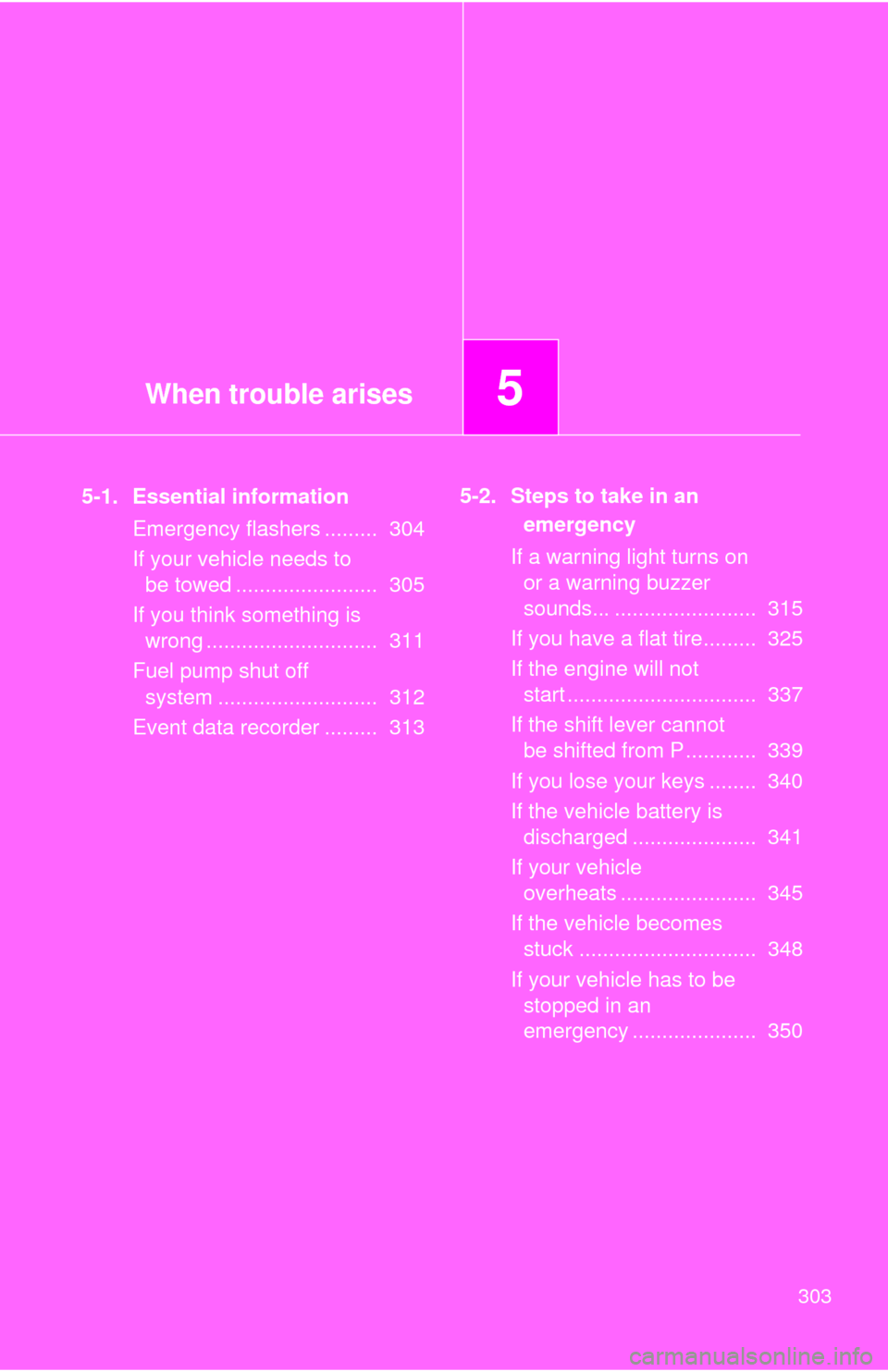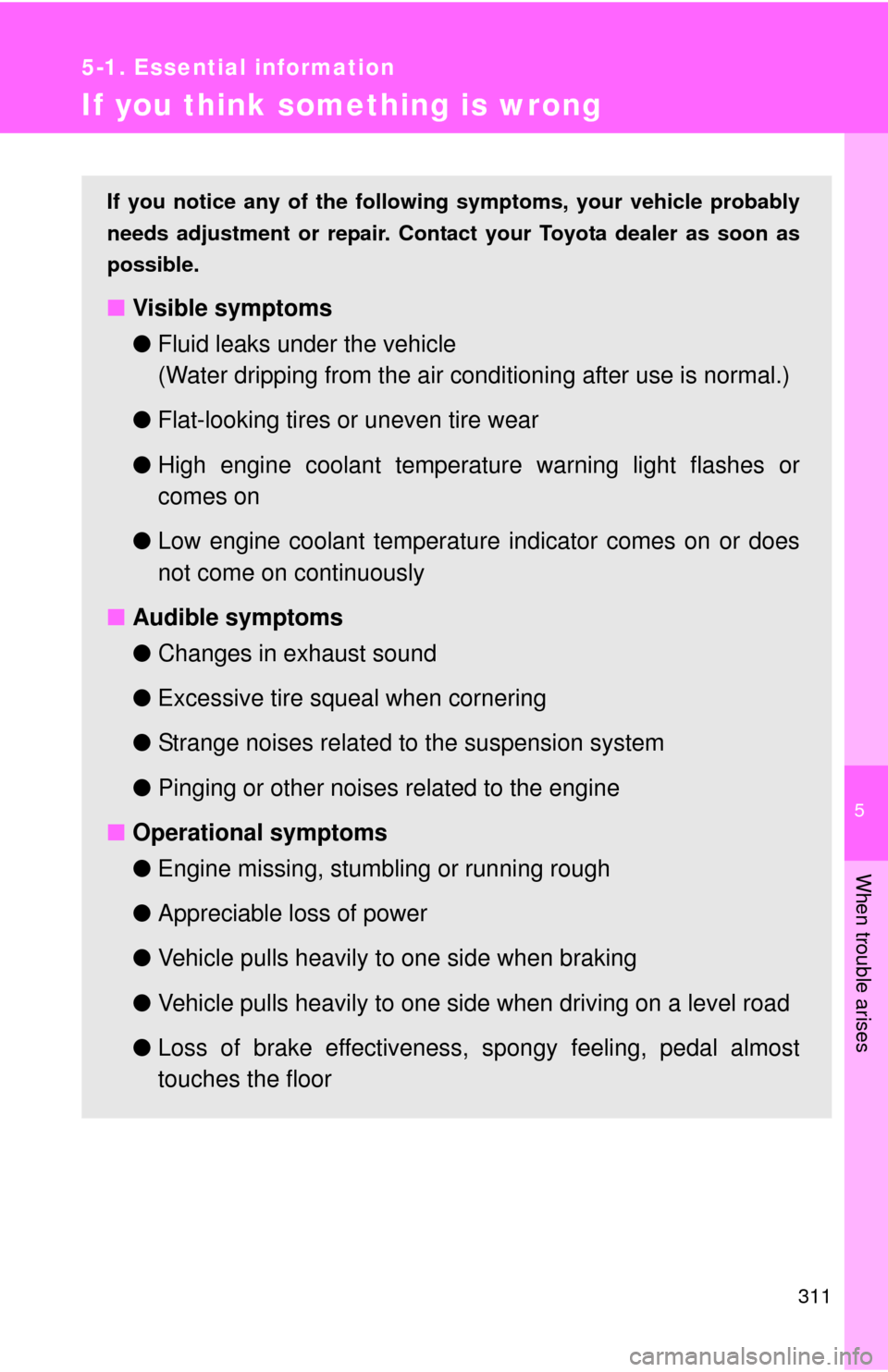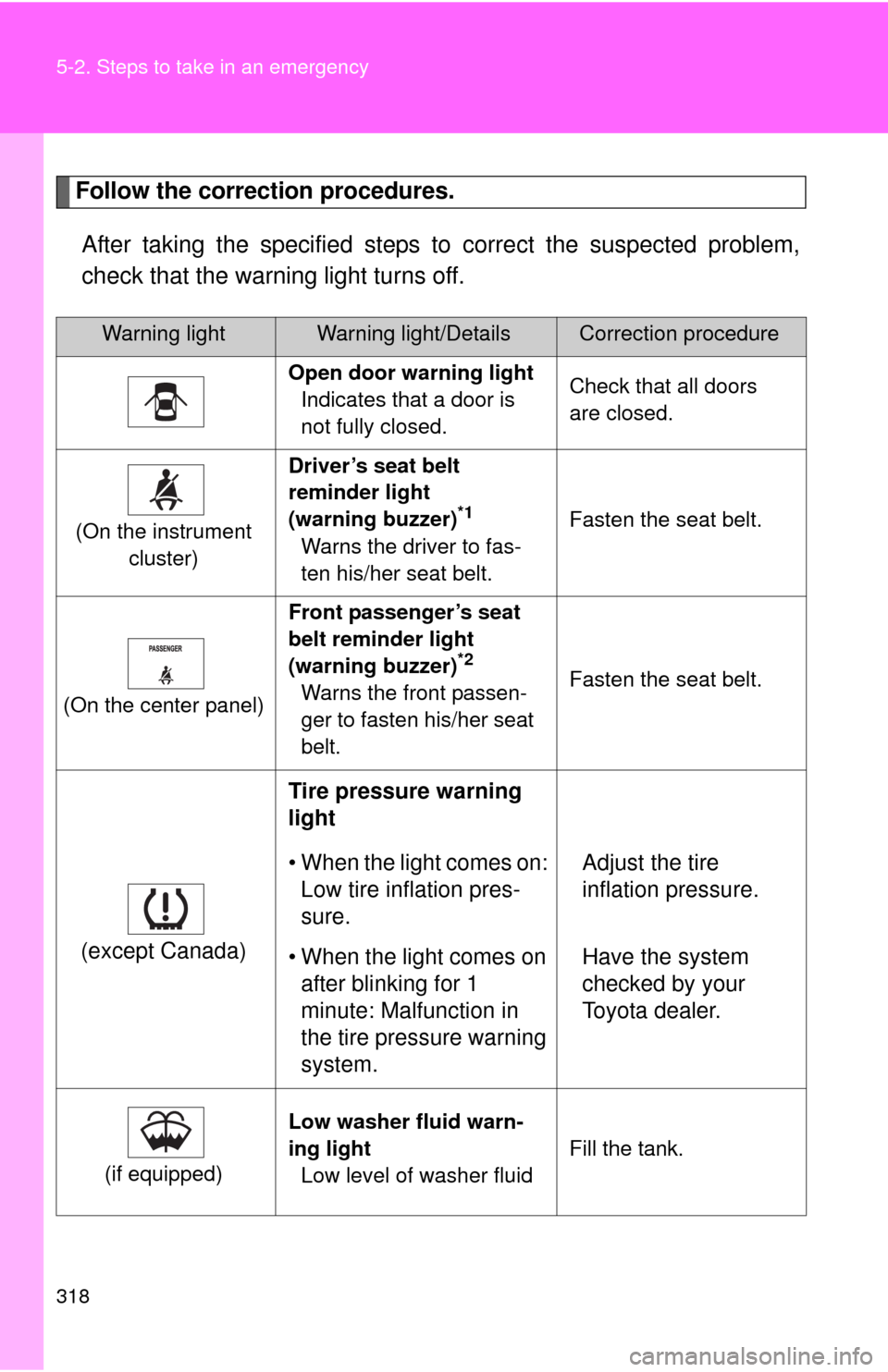2010 TOYOTA YARIS Tire warning light
[x] Cancel search: Tire warning lightPage 4 of 400

TABLE OF CONTENTSIndex
4
4-3. Do-it-yourself maintenance
Do-it-yourself service
precautions ...................... 247
Hood................................... 250
Positioning a floor jack ....... 251
Engine compartment .......... 253
Tires ................................... 266
Tire inflation pressure......... 272
Wheels ............................... 276
Air conditioning filter ........... 278
Key battery ......................... 281
Checking and replacing
fuses ................................ 283
Light bulbs .......................... 294
5-1. Essential information
Emergency flashers ........... 304
If your vehicle needs to be
towed ............................... 305
If you think something is
wrong ............................... 311
Fuel pump shut off
system .............................. 312
Event data recorder............ 3135-2. Steps to take in an emergency
If a warning light turns on
or a warning buzzer
sounds... ........................... 315
If you have a flat tire ........... 325
If the engine will not start .... 337
If the shift lever cannot be
shifted from P ................... 339
If you lose your keys ........... 340
If the vehicle battery is
discharged ........................ 341
If your vehicle overheats..... 345
If the vehicle becomes
stuck ................................. 348
If your vehicle has to be
stopped in an
emergency........................ 350
6-1. Specifications
Maintenance data
(fuel, oil level, etc.) ........... 352
Fuel information .................. 361
Tire information................... 364
6-2. Customization
Customizable features ........ 377
Items to initialize ................. 379
5When trouble arises
6Vehicle specifications
Page 267 of 400

267 4-3. Do-it-yourself maintenance
4
Maintenance and care
Ti
Installing tire pressure warning valves and transmitters
When replacing tires or wheels, tire pressure warning valves and
transmitters must also be installed.
When new tire pressure warning valves and transmitters are installed,
new tire pressure warning valve and transmitter ID codes must be regis-
tered in the tire pressure warning computer and tire pressure warning
system must be initialized. Have tire pressure warning valve and trans-
mitter ID codes registered by your Toyota dealer.
Registering ID codes
The tire pressure warning valve and transmitter is equipped with a
unique ID code. When replacing a tire pressure warning valve and
transmitter, it is necessary to register the ID code of tire pressure
warning valve and transmitter. Have the ID code registered by your
Toyota dealer.
■When to replace your vehicle’s tires
Tires should be replaced if:
●You have tire damage such as cuts, splits, cracks deep enough to
expose the fabric or bulges indicating internal damage
●A tire goes flat repeatedly or cannot be properly repaired due to the
size or location of a cut or other damage
If you are not sure, consult with your Toyota dealer.
■Replacing tires and wheels
If the ID code of the tire pressure warning valve and transmitter is not
registered, the tire pressure warning system will not work properly. After
driving for about 20 minutes, the tire pressure warning light comes on
after blinking for 1 minute to indicate a system malfunction.
■Tire life
Any tire over 6 years old must be checked by a qualified technician even
if they have seldom or never been used or damage is not obvious.
Page 303 of 400

When trouble arises5
303
5-1. Essential information
Emergency flashers ......... 304
If your vehicle needs to
be towed ........................ 305
If you think something is
wrong ............................. 311
Fuel pump shut off
system ........................... 312
Event data recorder ......... 3135-2. Steps to take in an
emergency
If a warning light turns on
or a warning buzzer
sounds... ........................ 315
If you have a flat tire......... 325
If the engine will not
start ................................ 337
If the shift lever cannot
be shifted from P............ 339
If you lose your keys ........ 340
If the vehicle battery is
discharged ..................... 341
If your vehicle
overheats ....................... 345
If the vehicle becomes
stuck .............................. 348
If your vehicle has to be
stopped in an
emergency ..................... 350
Page 311 of 400

5
When trouble arises
311
5-1. Essential information
If you think something is wrong
If you notice any of the following symptoms, your vehicle probably
needs adjustment or repair. Contact your Toyota dealer as soon as
possible.
■Visible symptoms
●Fluid leaks under the vehicle
(Water dripping from the air conditioning after use is normal.)
●Flat-looking tires or uneven tire wear
●High engine coolant temperature warning light flashes or
comes on
●Low engine coolant temperature indicator comes on or does
not come on continuously
■Audible symptoms
●Changes in exhaust sound
●Excessive tire squeal when cornering
●Strange noises related to the suspension system
●Pinging or other noises related to the engine
■Operational symptoms
●Engine missing, stumbling or running rough
●Appreciable loss of power
●Vehicle pulls heavily to one side when braking
●Vehicle pulls heavily to one side when driving on a level road
●Loss of brake effectiveness, spongy feeling, pedal almost
touches the floor
Page 318 of 400

318 5-2. Steps to take in an emergency
Follow the correction procedures.
After taking the specified steps to correct the suspected problem,
check that the warning light turns off.
Warning lightWarning light/DetailsCorrection procedure
Open door warning light
Indicates that a door is
not fully closed.Check that all doors
are closed.
(On the instrument
cluster)Driver’s seat belt
reminder light
(warning buzzer)
*1
Warns the driver to fas-
ten his/her seat belt.Fasten the seat belt.
(On the center panel)Front passenger’s seat
belt reminder light
(warning buzzer)
*2
Warns the front passen-
ger to fasten his/her seat
belt.Fasten the seat belt.
(except Canada)Tire pressure warning
light
• When the light comes on:
Low tire inflation pres-
sure.Adjust the tire
inflation pressure.
• When the light comes on
after blinking for 1
minute: Malfunction in
the tire pressure warning
system.Have the system
checked by your
Toyota dealer.
(if equipped)Low washer fluid warn-
ing light
Low level of washer fluidFill the tank.
Page 320 of 400

320 5-2. Steps to take in an emergency
■Key reminder buzzer
The buzzer indicates that the key has not been removed (with the engine
switch in the ACC or LOCK position and the driver’s door opened).
■Light reminder buzzer
The buzzer indicates that the headlight switch is left on (with the key
removed and the driver’s door opened).
■If the malfunction indicator lamp comes on while driving
First check the following:
●Is your vehicle low on gas?
If it is, refuel the vehicle immediately.
●Is the fuel tank cap loose?
If it is, tighten it securely.
The light will go off after taking several driving trips.
If the light does not go off even after several trips, contact your Toyota dealer
as soon as possible.
■Front passenger detection sensor and passenger seat belt reminder
If luggage or other load is placed on the front passenger seat, depending on
its weight, the reminder light to flash and buzzer to sound.
■
When the tire pressure warning light comes on
Check the tire inflation pressure and adjust to the appropriate level.
■The tire pressure warning light may turn on due to natural causes
The tire pressure warning light may turn on due to natural causes such
as natural air leaks or tire inflation pressure changes caused by temper-
ature. In this case, adjusting the tire inflation pressure will turn off the
warning light (after a few minutes).
■When a tire is replaced with a spare tire
The compact spare tire is not equipped with the tire pressure warning
valve and transmitter. If a tire goes flat, the tire pressure warning light will
not turn off even though the flat tire is replaced with the spare tire.
Replace the spare tire with the repaired tire and adjust the proper tire
inflation pressure. The tire pressure warning light will turn off after a few
minutes.
Page 321 of 400

5
When trouble arises
321 5-2. Steps to take in an emergency
■If the tire pressure warning system is inoperative
The tire pressure warning system will be disabled in the following condi-
tions:
(When the condition becomes normal, the system will work properly.)
●If tires not equipped with tire pressure warning valves and transmit-
ters are used.
●If the ID code on the tire pressure warning valves and transmitters is
not registered in the tire pressure warning computer.
●If the tire inflation pressure is 73 psi (500 kPa, 5.1 kgf/cm2 or bar) or
higher.
The tire pressure warning system may be disabled in the following condi-
tions:
(When the condition becomes normal, the system will work properly.)
●If electronic devices or facilities using similar radio wave frequencies
are nearby.
●If a radio set at similar frequencies is in use in the vehicle.
●If a window tint that affects the radio wave signals is installed.
●If there is a lot of snow or ice on the vehicle, in particular around the
wheels or wheel housings.
●If non-genuine Toyota wheels are used. (Even if you use Toyota
wheels, the tire pressure warning system may not work properly with
some types of tires.)
●If tire chains are used.
■If the tire pressure warning light comes on after blinking for 1
minute frequently
If the tire pressure warning light comes on after blinking for 1 minute fre-
quently when the engine switch is turned to the ON position, have it
checked by your Toyota dealer.
■After changing the engine oil (except Canada)
Make sure to reset the oil maintenance data. (P. 256)
Page 322 of 400

322 5-2. Steps to take in an emergency
■Customization that can be configured at Toyota dealer
●The vehicle speed linked seat belt reminder buzzer can be disabled.
(Customizable features P. 377)
●The key reminder buzzer can be disabled.
(Customizable features P. 377)
●The light reminder buzzer can be disabled.
(Customizable features P. 377)
CAUTION
■If the tire pressure warning light comes on
Be sure to observe the following precautions. Failure to do so could
cause loss of vehicle control and result in death or serious injury.
●Stop your vehicle in a safe place as soon as possible. Adjust the tire
inflation pressure immediately.
●If the tire pressure warning light comes on even after tire inflation pres-
sure adjustment, it is probable that you have a flat tire. Check the tires.
If the tire is flat, change to the spare tire and have the flat tire repaired
by the nearest Toyota dealer.
●Avoid abrupt maneuvering and braking. If the vehicle tires deteriorate,
you could lose control of the steering wheel or the brakes.
■If a blowout or sudden air leakage should occur
The tire pressure warning system may not activate immediately.
■Maintenance of the tire
Each tire, including the spare (if provided), should be checked monthly
when cold and inflated to the inflation pressure recommended by the
vehicle manufacturer on the vehicle placard or tire inflation pressure
label (tire and load information label). (If your vehicle has tires of a differ-
ent size than the size indicated on the vehicle placard or tire inflation
pressure label [tire and load information label], you should determine the
proper tire inflation pressure for those tires.)